STAG
On my grind
- Location
- Pleasant Grove
For work, it’s occasional that I need to run a corded 7” grinder. I work in an area with no utilities so this meant generator was a leading candidate for power. I used my personal 3,500 watt generator for a few weeks but it took up bedspace and would not have been difficult to steal, so I came up with option 2, which, in the end wasn’t really a flawless option, but it works for what I need it to.
Option 2 was to use a large power inverter. My other coworker’s work truck is a Powerboost F150 so it has a 5,200 watt inverter built in from factory, but the problem there is he is often not on my jobsite with me, so him having a Powerboost wasn’t a solution for my jobsite.
I knew Harbor Freight had affordable power inverters, and so I took the company credit card and bought one. Only to realize in hindsight, that you don’t run that large of power inverters directly off your vehicle’s starting battery. I originally thought I could do just that, and be into this project for way less than the cost of a generator. But, now that I think about it, it makes complete sense that you don’t run that power off your battery, you’ll be stranded with a dead battery and no way home.
All fine and dandy, that just meant a few more components than what I originally had planned for. Deep Cycle batteries and a charger to charge the battery bank when the engine is running.
_________
Let’s get to the used components at least; I went with the cheaper, “modified sine-wave” power inverter, in comparison to a “pure sine wave” version. From what I understand, if you’re running sensitive electronics, go pure. However I’m mainly just running a large grinder, and maybe a microwave in the future. Maybe a saw here or there. But the added cost of a pure-sine wave seemed like not a needed investment.
I knew 3000 watts would have been plenty for my needs, but the 5000 watt one was only like $30 more, and the way my mind convinced me that the extra capacity would translate to not ever nearing its max-capability’s so I chose the 5000w version. I’m sure someone will chime in with science about how the 3000w would have actually been better for some reason or another, but it’s done.
Harbor Freight 5000w modified sine wave inverter

And also bought their 2ga battery cables for connecting the batteries to the inverter. I bought the 6-ft version and cut them in half to get my enough pieces for 2 batteries.
Harbor Freight 2ga - 6ft battery cable
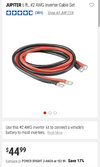
I hopped on Amazon and bought a 20amp DC-DC charger. I know nothing about the conversion factors for amperage to charging speed etc, but I figure that I do a lot more driving than I do using the inverter, so I figured even if it’s slow-charging then I think 20amp would be enough. If it’s not, I’ll deal with that later, but the 20a one was priced right and I really don’t think it will be an issue. I’m sure someone smarter than I will say that this is an incorrect component for the task, but I’m trying it.
Renogy 20Amp DC-DC charger
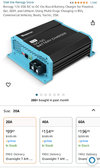
I built a wooden box to mount the inverter and charger to, and oriented it to where I could fit it all inside the toolbox. In this picture, the DC-DC charger is in the red circle on the right, but not wired up. You can see there’s room for a third battery if needed in the future, but so far that hasn’t been needed. Yes, I know lithium batteries would have been the better choice here than optima AGM’s, but, YOLO. If I kill these Optima’s then I’ll look into lithiums in the future.
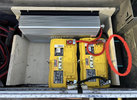
I 3D printed a battery hold-down bracket
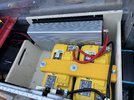
And used some 6ga jumper cablesto run from the starting battery to the DC-DC charger. I know this is slightly redneck, but in my experience it’s a good affordable way to get reasonably large electrical cable ran a longish distance. And they are paired together so that makes it easier to run the cable down the frame of the truck.
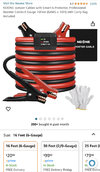
And lastly I used a 6ga fuse holder to install a fuse for the DC-DC charger
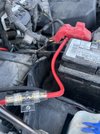
I still need to run one more small (like 16ga) wire from the charger to signal it that the engine is running and that it can draw charging current.
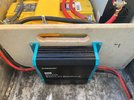
I also posted this picture on FB in an automotive electrical wiring group because I was proud of the crimp, but had made a bonehead move of forgetting the heatshrink before crimping the lug. This picture caused a lot of controversy on whether or not it is a correct (good) crimp or incorrect (bad) crimp. Personally, I think that it’s correct and I’ll continue to keep doing them that way. (I have a hydraulic hex crimper for the other style of lugs, like copper battery lugs like you can see in the background that I used on the 2ga battery cable)
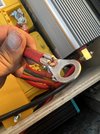
Anyways, I’ve used it a handful of times so far and it does what I need it to. In the end, I’m as much money into it as just buying a generator, but sometimes I learn stuff the hard way.
Option 2 was to use a large power inverter. My other coworker’s work truck is a Powerboost F150 so it has a 5,200 watt inverter built in from factory, but the problem there is he is often not on my jobsite with me, so him having a Powerboost wasn’t a solution for my jobsite.
I knew Harbor Freight had affordable power inverters, and so I took the company credit card and bought one. Only to realize in hindsight, that you don’t run that large of power inverters directly off your vehicle’s starting battery. I originally thought I could do just that, and be into this project for way less than the cost of a generator. But, now that I think about it, it makes complete sense that you don’t run that power off your battery, you’ll be stranded with a dead battery and no way home.
All fine and dandy, that just meant a few more components than what I originally had planned for. Deep Cycle batteries and a charger to charge the battery bank when the engine is running.
_________
Let’s get to the used components at least; I went with the cheaper, “modified sine-wave” power inverter, in comparison to a “pure sine wave” version. From what I understand, if you’re running sensitive electronics, go pure. However I’m mainly just running a large grinder, and maybe a microwave in the future. Maybe a saw here or there. But the added cost of a pure-sine wave seemed like not a needed investment.
I knew 3000 watts would have been plenty for my needs, but the 5000 watt one was only like $30 more, and the way my mind convinced me that the extra capacity would translate to not ever nearing its max-capability’s so I chose the 5000w version. I’m sure someone will chime in with science about how the 3000w would have actually been better for some reason or another, but it’s done.
Harbor Freight 5000w modified sine wave inverter

And also bought their 2ga battery cables for connecting the batteries to the inverter. I bought the 6-ft version and cut them in half to get my enough pieces for 2 batteries.
Harbor Freight 2ga - 6ft battery cable

I hopped on Amazon and bought a 20amp DC-DC charger. I know nothing about the conversion factors for amperage to charging speed etc, but I figure that I do a lot more driving than I do using the inverter, so I figured even if it’s slow-charging then I think 20amp would be enough. If it’s not, I’ll deal with that later, but the 20a one was priced right and I really don’t think it will be an issue. I’m sure someone smarter than I will say that this is an incorrect component for the task, but I’m trying it.
Renogy 20Amp DC-DC charger

I built a wooden box to mount the inverter and charger to, and oriented it to where I could fit it all inside the toolbox. In this picture, the DC-DC charger is in the red circle on the right, but not wired up. You can see there’s room for a third battery if needed in the future, but so far that hasn’t been needed. Yes, I know lithium batteries would have been the better choice here than optima AGM’s, but, YOLO. If I kill these Optima’s then I’ll look into lithiums in the future.

I 3D printed a battery hold-down bracket

And used some 6ga jumper cablesto run from the starting battery to the DC-DC charger. I know this is slightly redneck, but in my experience it’s a good affordable way to get reasonably large electrical cable ran a longish distance. And they are paired together so that makes it easier to run the cable down the frame of the truck.

And lastly I used a 6ga fuse holder to install a fuse for the DC-DC charger

I still need to run one more small (like 16ga) wire from the charger to signal it that the engine is running and that it can draw charging current.

I also posted this picture on FB in an automotive electrical wiring group because I was proud of the crimp, but had made a bonehead move of forgetting the heatshrink before crimping the lug. This picture caused a lot of controversy on whether or not it is a correct (good) crimp or incorrect (bad) crimp. Personally, I think that it’s correct and I’ll continue to keep doing them that way. (I have a hydraulic hex crimper for the other style of lugs, like copper battery lugs like you can see in the background that I used on the 2ga battery cable)

Anyways, I’ve used it a handful of times so far and it does what I need it to. In the end, I’m as much money into it as just buying a generator, but sometimes I learn stuff the hard way.

